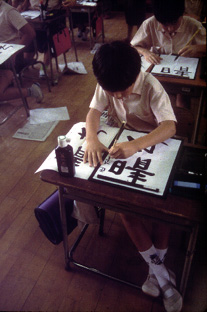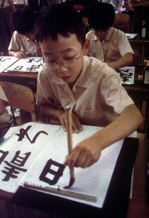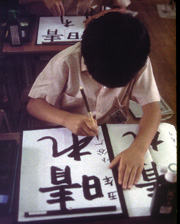

#3

A calligraphy set consists of:
Shodo is the Japanese word for Calligraphy. It means not just penmanship, but the Way or the Path of writing. In China and Japan, Shodo has long been regarded as one of the most important forms of art. The Japanese have two sets of characters for writing sounds. Hiragana have rounded strokes, while Katakana use mostly straight lines. Katakana are used mainly to write words borrowed from other languages and names of foreign people and places as well as to denote sounds and cries of animals
Japanese character-writing has two stages. First, a student gets acquainted with the tools and learns a basic technique for handling them; this is the SHUJI stage. When he has this technique and can write freely various letters, he goes on to a deeper,more artistic level, SHODO. Every student must understand the history and proper use of the calligrapher's tools. As the calligraphic styles evolved over the centuries, calligraphers struggled, to refine their techniques and through trial and error have brought Shodo to the present high level of achievement. The traditions of Wang Hsi-chin, Ou-yang Hsun, the Han Clerical styles, and the Six Dynasty styles were all created from these crucibles of experience. It has become standard practice to study these techniques in order to become a full-fledged calligrapher.
#1 |
#2 |
#3
|
As I watched young children practice their writing, I was reminded of what an old Chinese calligrapher, I met in China said about his art. "I always meditate a few minutes before picking up the brush. This clears my mind of worldly things and then I visualized the character on the page in it's finished state. Then I simply traced over the image I see in my mind. " I videotaped a jr. high student as he began to create a character and I saw him take a big breath , then stare at the paper , take another breath and began his first stroke with a very steady hand. You might remember this technique if decide to let your students try.
 |
|
 Links:
Links:
Calligraphy is an art form that has been studied for over three thousand years. A knowledge of calligraphy is an important step in the understanding of Japanese culture. Calligraphy is not merely an exercise in good handwriting, but rather the foremost art form of the Orient. It is the combination of the skill and imagination of the person who has studied intensely the combinations available using only lines. In the West, calligraphy was intended to suppress individuality and produce a uniform style. Japanese calligraphy (sho in Japanese) attempts to bring words to life, and endow them with character. Styles are highly individualistic, differing from person to person. Japanese calligraphy presents a problem for westerners trying to understand it; the work is completed in a matter of seconds so the uninitiated cannot really appreciate the degree of difficulty involved. However, bear in mind that the characters must be written only once. There is no altering, touching up, or adding to them afterwards.
Some of this is from the web site listed below. Pictures
are.
|
http://www.primenet.com/~bec/calligraphy.html